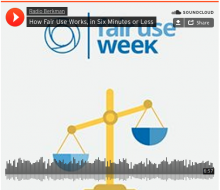On this episode Olga and Leo, two law students working at the Harvard Cyberlaw Clinic, introduce the fair use doctrine, and describe the four different factors that determine whether a use is fair. Those factors are:
- the purpose and character of the use;
- the nature of the copyrighted work;
- the amount and substantiality of the use; and
- the effect on the market for the underlying work.
Summary
An artist, musician, or writer can’t just take another person's creation and claim it as their own. Federal law outlines how creators can and can’t borrow from each other. These rules are collectively called "copyright law," and essentially they give creators the exclusive right to copy, modify, distribute, perform, and display their creative works.
Copyright law was originally created as an incentive. If creators aren’t worrying about whether someone might steal their work, they’re more likely to share their ideas with the public. This kind of sharing in turn helps to create more ideas, products, jobs, art, and whole industries.
But even with copyright there are exceptions, or times where another artist can use a copyrighted work within getting the copyright holder’s permission. This safe zone is called "Fair Use."

